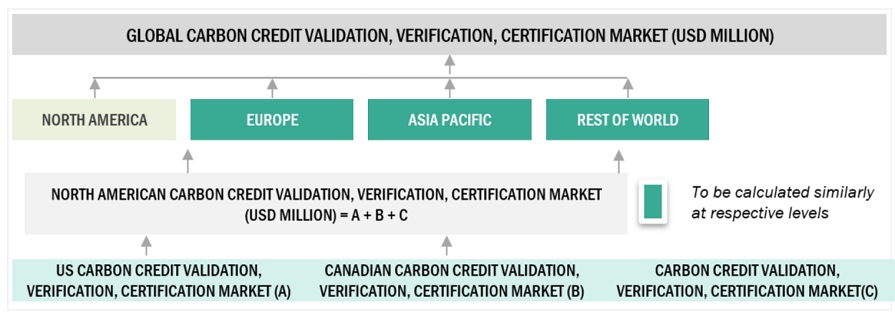This study encompassed significant efforts in determining the present size of the carbon credit validation, verification, certification market. It commenced with a thorough secondary research process to gather data related to the market, similar markets, and the overarching industry. Subsequently, these findings, assumptions, and market size calculations were rigorously validated by consulting industry experts across the entire supply chain through primary research. The total market size was assessed by conducting an analysis specific to each country. Following that, the market was further dissected, and the data was cross-referenced to estimate the size of various segments and sub-segments within the market.
Secondary Research
In this research study, a wide range of secondary sources were utilized, including directories, databases, and reputable references such as Hoover's, Bloomberg BusinessWeek, Factiva, World Bank, International Monetary Fund (IMF), the US Department of Energy (DOE), and the International Energy Agency (IEA). These sources played a crucial role in gathering valuable data for a comprehensive analysis of the global carbon credit validation, verification, certification market, covering technical, market-oriented, and commercial aspects. Additional secondary sources included annual reports, press releases, investor presentations, whitepapers, authoritative publications, articles authored by well-respected experts, information from industry associations, trade directories, and various database resources.
Primary Research
The carbon credit validation, verification, certification market involves a range of stakeholders, including project developers, certification bodies, auditors/third party verifiers, and end users within the supply chain. To gather qualitative and quantitative insights, various primary sources from both the supply and demand sides of the market were interviewed. The following breakdown presents the primary respondents involved in the research study.

To know about the assumptions considered for the study, download the pdf brochure
Market Size Estimation
The estimation and validation of the carbon credit validation, verification, certification market size have been conducted using a bottom-up approach. This approach was rigorously employed to ascertain the dimensions of multiple subsegments within the market. The research process comprises the following key stages.
-
In this method, the statistics for each type of carbon credit validation, verification, certification have been examined at both the country and regional levels.
-
Thorough secondary and primary research has been conducted to gain a comprehensive understanding of the global market landscape for various segments of carbon credit validation, verification, certification market.
-
When calculating and forecasting the market size, qualitative factors such as market drivers, limitations, opportunities, and challenges have been taken into account.
Global Carbon Credit Validation, Cerification, Certification Market Size: Bottom-Up Approach

Data Triangulation
The process of determining the overall market size involved the methodologies described earlier, followed by segmenting the market into multiple segments and subsegments. To finalize the comprehensive market analysis and obtain precise statistics for each market segment and subsegment, data triangulation and market segmentation techniques were applied, as appropriate. Data triangulation was accomplished by examining various factors and trends from both the demand and supply perspectives within the ecosystem of the carbon credit validation, verification, certification market.
Market Definition
The Carbon Credit Validation, Verification, and Certification market encompasses the processes and services involved in ensuring the integrity and credibility of carbon credits used in emissions trading and offset programs. This market includes the validation of carbon reduction projects, the verification of actual emissions reductions achieved, and the certification of these reductions by accredited bodies. These activities provide assurance to buyers and stakeholders that the carbon credits are legitimate, quantifiable, and compliant with established standards and regulations, thereby facilitating transparent and reliable carbon trading and contributing to global climate change mitigation efforts.
Key Stakeholders
-
Government & research organizations
-
Institutional investors
-
Investors/shareholders
-
Environmental research institutes
-
Project developers
-
State and national regulatory authorities
-
Manufacturing industry
-
Energy efficiency consultancies
-
Certification bodies
Objectives of the Study
-
To describe and forecast the carbon credit validation, verification, certification market, in terms of value, by type, sector, and region
-
To forecast the market for various segments, in terms of value, with regard to four regions: North America, Europe, Asia Pacific, and Rest of World, along with their key countries
-
To provide detailed information about the key factors, such as drivers, restraints, opportunities, and challenges, influencing the market’s growth
-
To strategically analyze the subsegments with respect to individual growth trends, prospects, and contributions of each segment to the overall market size
-
To study the complete supply chain and allied industry segments and perform a supply chain analysis of the carbon credit validation, verification, certification landscape
-
To strategically analyze the regulatory landscape, tariff, standards, patents, Porter’s five forces, import and export scenarios, trade values, and case studies pertaining to the market under study
-
To analyze the opportunities in the market for various stakeholders by identifying the high-growth segments of the carbon credit validation, verification, certification market
-
To profile the key players and comprehensively analyze their market position in terms of ranking and core competencies1, along with detailing the competitive landscape for the market leaders
-
To analyze competitive developments such as agreements, partnerships, product launches, acquisitions, contracts, expansions, and investments in the carbon credit validation, verification, certification market
Available Customization
With the given market data, MarketsandMarkets offers customizations based on the company’s specific needs. The following customization options are available for the report:
Product Analysis
-
Product Matrix, which provides a detailed comparison of the product portfolio of each company
Company Information
-
Detailed analyses and profiling of additional market players (up to 5)



Growth opportunities and latent adjacency in Carbon Credit Validation Verification and Certification Market